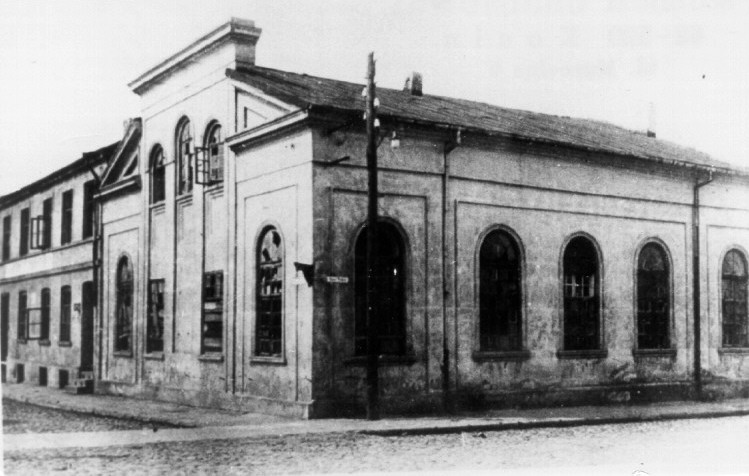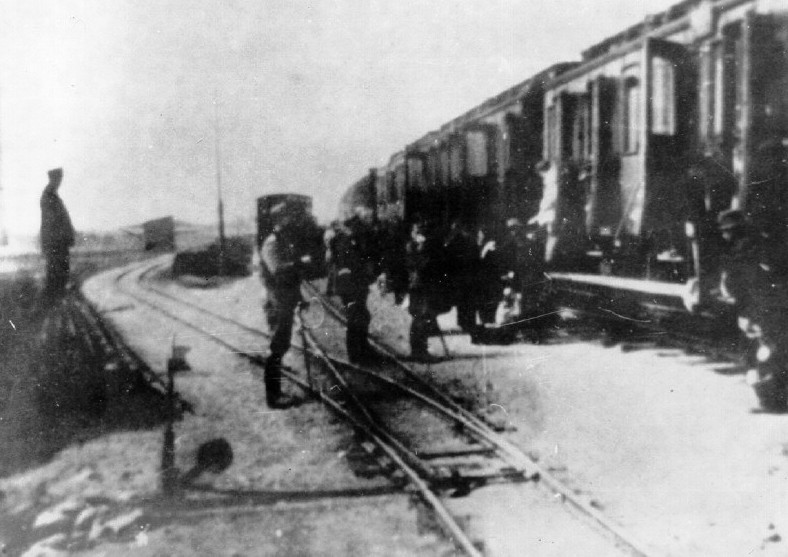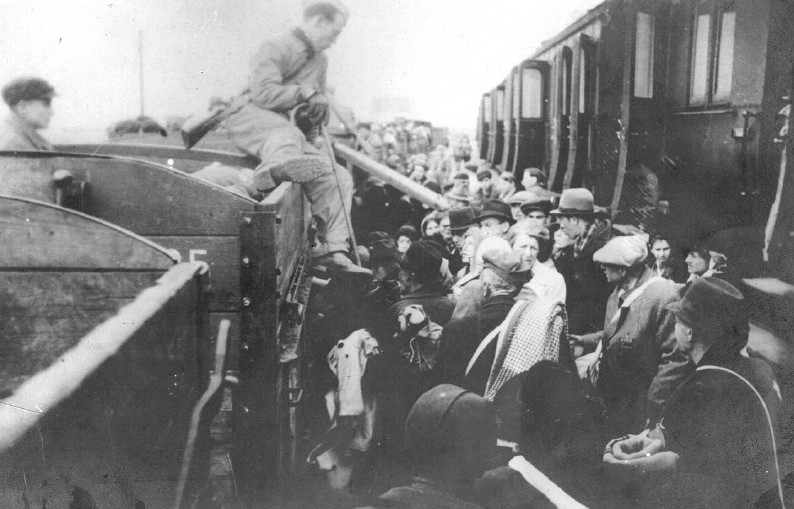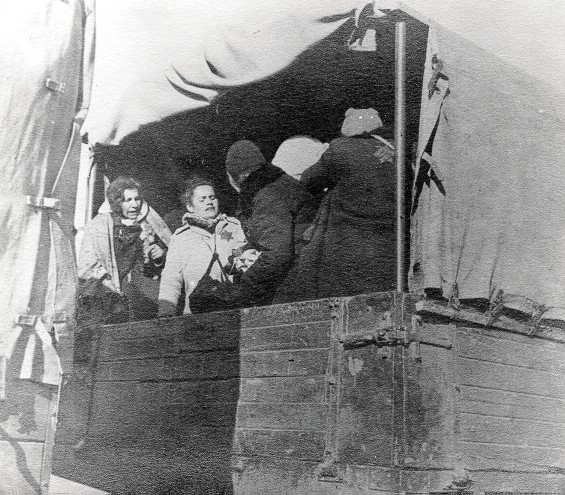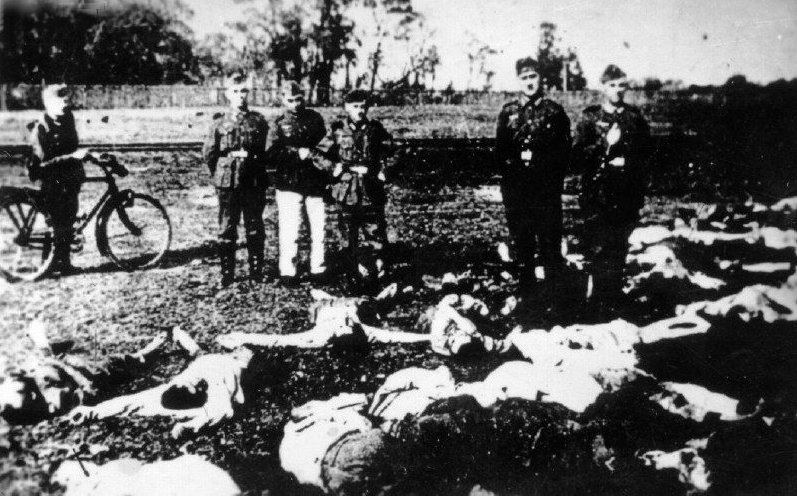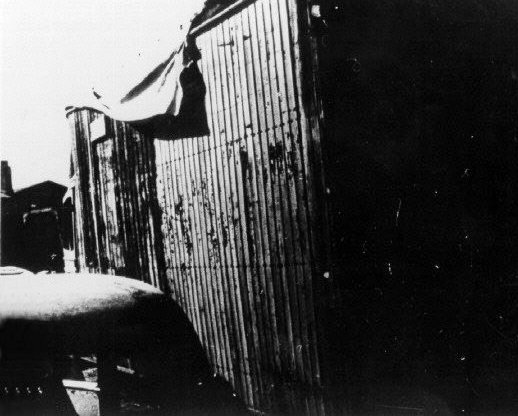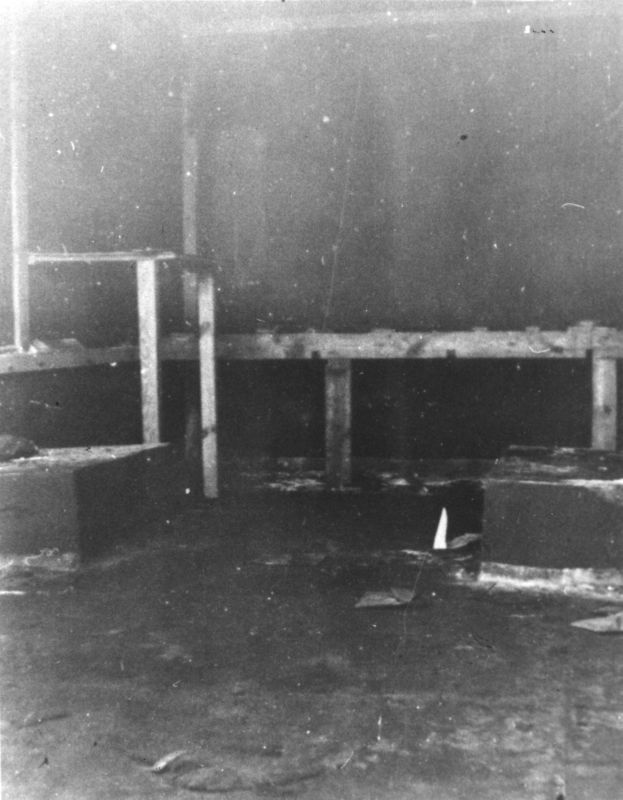Holocaust Education & Archive Research Team |
|
Survivor Stories
Holocaust Survivors Chelmno Survivors Righteous Gentiles Holocaust Recalled
| |||||||||||||||||||||
Michal Podchlebnik Chelmno Survivor Testimony
Protocol of the Interrogation of the Witness
On June 9 1945 in Kolo
Examining Judge of District Court in Lodz – Wladyslaw Bednarz
Assisted by Recording Clerk
In the presence of the parties Deputy Prosecutor K.K Leszczynski heard a testimony (not under oath) of the witness mentioned below. After the witness had been informed of criminal responsibility for a false testimony and acquainted with the text of article 106 of the Code of Penal Proceedings, he testified the following:
Before the war and at the beginning of the German occupation I had resided permanently in Kolo. In late December 1941 ( I cannot remember the date exactly) formations of the NSKK – National Socialist Motor Corps surrounded the town of Kolo – (their members wore black military field caps and green uniforms).
Jews were driven out of their flats and led to the house of the Jewish Committee at 6 Rzeznicza Street. Entire families were deported and each person could take a pack of weight not exceeding 10 kilograms.
They were placed in a Jewish temple and in the aforementioned building housing the Jewish Committee, which was attached to the synagogue. When cars arrived, entire Jewish families left the building carrying their baggage.
In front of the building, by the entrance there was an SS officer sitting at a table. He had a list of all Jewish residents of Kolo and ticked off the names of all those who were getting into the vehicles. The baggage was loaded into a trailer.
The guards and members of the Jewish Committee said that the Jews would be transported to work “at a railroad.” About 40 people were loaded into each car. Two trucks transported Jews from Kolo. The drivers were Germans.
About 1,000 people were driven away each day. Among the members of the escort team for the vehicles was a Volksdeutsche Siuda from the village of Koscielec, who at that time worked for the military police. He said to the Jews,
“Don’t be afraid. They are going to take you to Barlogi train station and from there to the East.”
He was known among local Jews and they believed his words. Each truck made 10-12 rides a day which made us believe that the Jews were driven off not far from Kolo.
I did not go only because at that time I was a resident of the village of Bugaj in Kolo County, and my name was not on the list of Kolo residents. I led my father, mother, sister with her five children, brother with his wife and three children to the truck. I helped load packs into the trailer. I even volunteered to go with my parents, but was not allowed to.
I witnessed a situation when a person known as Goldberg, a sawmill owner from Kolo applied to the German authorities to be appointed the manager of the East camp for Jews from Kolo after his son had been driven away. The application was accepted and he was promised to be appointed the manager.
In the meantime, some little boy accidentally came to the Jewish Committee house and said that the Jews were not transported to the train station in the village of Barlogi, but to Chelmno, which he had seen himself. The Germans explained that in Chelmno they only select the strongest workers to work in the West. The ill were driven off on the last day. The drivers were told to drive slowly and carefully. The operation in Kolo lasted 4-5 days.
In early January 1942 (I cannot remember the exact date, but I remember it was a Friday) on the orders of the Jewish Committee, I worked on the demolition of a barn in Bugaj.
From there 14 local Jews and I were taken to the gendarmerie station. Allegedly we were arrested because my cousin Mordka Podchlebnik had escaped. Gendarme Szplit a Volksdeutsche from the village of Babiak who once had some conflict with a Jew named Dankowski, also from Babiak, said the following about the Jew, “He wont live long now.”
Dankowski was arrested in the morning. On Saturday at about 4pm a truck brought 15 Jews from the village of Izbica. At the same time a smaller car brought an SS officer, whom I knew from the mentioned Kolo operation (he ticked off the names of Jews getting into the truck).
We and the Jews from Izbica were loaded into a truck and taken to Chelmno. Let me point out that all the Jews in the vehicle were well-built, strong and capable of doing even the toughest work. The car rolled into the palace grounds in Chelmno. The whole terrain was surrounded by a recently erected 2.5 – three metre high fence made of wooden boards.
The fence had no gaps so that nobody could see what was going on inside. The gates were opened and the truck drove into the grounds and stopped in front of the palace.
After a while another gate was opened and the car was let into the inner palace grounds. When the vehicle was entering the inner grounds, I raised the tarpaulin and noticed a pile of used clothes. We got out of the truck. SS-men formed a double line leading as far as the palace basement. In order to hurry us to move fast between the two rows of SS-men, they repeatedly hit us with gun butts shouting “faster, faster.”
Throughout all Sunday morning nothing happened. We were just sitting in the basement doing nothing. For physiological needs there was a bucket which was carried out and emptied by one of the inmates under a strong escort. The inmate noticed that there were guards all over the place.
Many signatures appeared on the basement wall among others the signature of Mr Kaliski from the town of Dabie. There was also a significant line in Yiddish, “He who comes here, does not walk away alive.” We had no illusions about our fate.
On Monday morning, 30 Jews were taken to work in the woods. Ten others including me stayed in the basement. There was a window in the basement, but it had been nailed up with wooden boards . At about 8am a truck stopped in front of the palace. I heard a German voice, he was talking to those who had just arrived, he said,
“You will go to the East. There are large areas where you can work. All you have to do now is to put on the clean clothes you will be given and take a shower.” Then the newcomers started clapping their hands. Some time later we heard a shuffle of bare feet in the basement near our cell. We heard the Germans shouting, “Faster, Faster.”
I realised they were leading the Jews to the inner grounds. Suddenly, I heard a truck door slam followed by an outburst of screaming and banging on the truck’s walls. Then I heard the engine start and after six-seven minutes, when the screams fainted and died, the truck left the palace grounds. Next we were ordered to go to a large room upstairs. On the floor we could see men’s clothes and women’s coats and shoes scattered about.
We were told to carry all the clothes and shoes to some other room quickly. In the new room there were already a lot of clothes and shoes. We put the shoes in a separate pile. Having finished the task, we were herded back to the basement cell.
Another truck arrived and the whole procedure was repeated. This lasted all day long. I noticed that more trucks arrived at the grounds than left. I came to the conclusion that trucks leaving Chelmno must have had larger carrying capacity. I would like to point out that in the room where the Jews undressed there were two stoves, both giving off significant amount of heat.
When our inmates returned from the woods in the evening, they said that they had been burying Jews from Klodawa in a common grave in the woods. They removed the corpses from large black vans, in which according to their accounts, Jews had been poisoned with exhaust fumes.
The corpses were in underwear, in the van there were some towels and pieces of soap. This convinced me that Jews, having undressed, were given towels and soap and led to the basement, where allegedly they were supposed to take a shower.
Three or four of those working in the wood that day did not return as they had been working badly and had been shot on the spot. The following day I volunteered to work in the woods.
While I was leaving, I saw a large van with its back end up against the palace. The door was open. A footbridge made it easier to get into the vehicle. What drew my attention was a wooden grate on the van floor, just like those in a bathhouse.
About 30 workers including me were loaded into two vehicles – a truck and a bus – and driven to the woods near Chelmno. We were escorted by about thirty SS-men. In the woods there was a trench serving as a mass grave for the murdered Jews. We were ordered to dig the trench further. In order to do so, we were given shovels and pickaxes.
At about 8am the first car from Chelmno arrived. When the van’s door was opened, dark smoke with a white tint belched out from the inside. We were not allowed to approach the van at that moment and could not even look in the direction of the open door.
I noticed that the Germans, having opened the door, ran away from the vehicle. I cannot tell whether the gas coming out from the inside was an exhaust gas or some other gases. We usually had to wait for so long that I did not smell the gas. Gas masks were not used.
After three or four minutes had passed three Jews went into the van. These were Neunmuller from Kolo, Chaim from Babiak and more whose name I cannot remember. They threw out the corpses from the vehicle onto the ground.
The corpses were haphazardly piled one on another as high as half way up the side of the van. Some of those murdered died holding their loved ones in their arms. The corpses generally did not look bad. I did not notice anyone with their tongue sticking out of their mouths or with any unnatural bruises.
The bodies were still warm. I could not smell any gas. Some were still alive. In such cases SS-men killed them by shooting them in the back of the head. After the van had been emptied of the bodies, it returned to Chelmno. Two Jews passed the corpses to two “Ukrainians” whose names I do not know. They spoke Polish and wore civilian clothes.
There was one more “Ukrainian” but he was accidentally trapped in the van and gassed along with other Jews. They tried to rescue him by artificial respiration but the attempt was unsuccessful. I was there and saw it myself.
The “Ukrainians” pulled out gold teeth from the corpses’ mouth, tore off little sacks of money from their necks, pulled off wedding rings, watches and so on. The corpses were searched over very precisely. The “Ukrainians” were looking for gold and valuables even in women’s reproductive organs and anuses. They did not use rubber gloves.
The valuables found were placed in a special suitcase. It was not the SS-men who searched through the corpses. They just attentively watched the Ukrainians doing it. After the bodies had been searched, they were placed in trenches in layers. They were placed very tightly in layers facing down in such a way that someone’s head touched someone else’s feet. They had not been stripped of their underwear. The trench was 6 metres deep, 6-7 metres wide (at the top).
Four to five corpses were placed on the first layer on the bottom, on the last, upper layer there were as many as 30 bodies. Then the bodies were buried under a 1-metre thick layer of earth. I noticed a few times that after a night the earth had been dug up in some places, exposing the corpses buried on the previous day.
I heard that this happened when the terrain was not guarded during the night. When I worked there, the length of the trench –grave was over 10 metres. About 1,000 people were buried a day, which filled three to four metres of trench.
The van in which the victims were gassed could take 80-90 people at a time. During my stay in Chelmno, two cars were used simultaneously. In addition, there was another van, the largest of the three, but it was out of order and remained in Chelmno in the yard (I saw it had had one wheel taken off).
Twelve to thirteen vans a day arrived in the woods. On this basis I figured that about 1,000 people were gassed every day. Jews who carried the corpses from the van had to remove the wooden floor grate from the vehicle and clean the car thoroughly. The valuables were also placed in the suitcase. The towels and pieces of soap were collected separately and driven back on daily basis.
The third van which came to Chlemonski’s Square on that day (Tuesday) brought the bodies of my wife and two children – a 7 year-old boy and a 4-year old girl. They were thrown out of the vehicle. I laid myself down near my wife’s body and wanted to be shot. An SS-man approached me and said, “this burly man can still work very well.”
He whipped me three times and forced me to continue working. At midday they gave us food. We had to get out of the trench without shovels and form a circle. The SS-men formed an outer circle around us. We were given black coffee and food brought in packs by Jews.
Generally we were fed well. That evening Krzewacki from Klodawa (whose given name I cannot remember) hung himself in the basement. Another Jew, whose name I cannot remember either, did the same. I was going to hang myself too, but was finally persuaded not to do that.
I worked 10 days in Chelmno. The process of exterminating Jews was repeated every day. The woods were not fenced in at that time. There were no furnaces for burning corpses either. I witnessed the extermination of Jews from Bugaj and then Izbica. On Friday they brought gypsies from Lodz. On Saturday the first transport from Lodz ghetto arrived.
At the time of the arrival, our labour group underwent selection. The weakest 20 Jews were killed and replaced with Jews from Lodz. At night we talked with our new companions. They were locked in a separate cell.
They asked us whether the camp was good and whether they would receive much bread. When I told them the truth, they answered, “We volunteered to work in Kolo.” Since the very beginning I had been trying to persuade my inmates to escape, but they were so depressed they could not make up their minds.
During my stay in Chelmno, I saw Zimermann arrive at the Chelmno woods. He was accompanied by two Germans, I did not know. He examined the corpses, talked to SS officers and laughed. Soon he went back to Kolo. I did not see any locals contacting SS-men. The Chelmno woods were guarded by about eighty SS-men. On the basis of my observations the total number of SS-men serving in Chelmno was about 120 – 130.
When on duty they were generally sober. Their duties remained the same, and so I was well familiar with the faces of those who escorted us. The SS-men wore gendarme uniforms and SS badges on their collars.
It appeared that they were housed in the village, but I do not know that exactly. We worked until dusk. During work we were often beaten. If somebody did not work efficiently he had to lie down on a pile of corpses and was shot in the back of the head with a pistol.
The gendarmes did not talk to one another in our presence. When they talked to us, these were just brief exchanges. Sometimes they threw a package of cigarettes into the trench so that we could smoke.
The drivers were all Germans .Actually I do not know – they wore civilian clothes. But for sure they were not Kolo residents. Where the SS-men doing their service in Chelmno came from, I do not know. I cannot remember any names. The executions every day looked the same. The SS-men were extremely cruel towards Jewish workers and punished them even for a minor offence. They killed for any reason.
On the way to work, I noticed that one of the windows on the bus could be lowered. I told my companion Winer from Izbica (whose first name I cannot remember). I suggested an escape attempt.
The following day on the way to work we intended to jump through the window and run away to the woods. However, we were separated and I had to get into the truck, while Winer into the bus. I decided to escape on my own.
When the truck was in the woods, I asked the escorting SS-man for a cigarette. When he gave me what I wanted, I stepped back and my companions surrounded him asking for cigarettes for themselves.
With a sudden movement I cut the tarpaulin on the driver’s side with a knife I had on me and jumped out of the car. They started shooting at me but all bullets missed the target. Luckily the bus did not follow the truck, so I was only shot at only from the truck.
The fact that the bus did not follow, made me think that Winer must have escaped and consequently the bus had to be stopped. While I was running away through the woods, some man on a bicycle tried to stop me, shooting at me with a pistol. I managed to escape - I went into some barn and hid in the hay. The following morning I heard some peasants near the barn talking about Germans looking for some escaped Jews.
After two days, during which I did not eat anything. I snuck out of the barn and headed in the direction of Grabow town. On my way I stopped at some peasant’s cottages (I do not know his name). He gave me some food and a hat, shaved me and showed the way.
In Grabow I met Winer from Izbica. Then I went to the town of Rzeszow and lost all contact with the region of Chelmno. Winer probably died in the Zamosc region in south eastern Poland, I think in 1944.
Here the protocol was closed and, after being read, signed.
(signature) Michal Podchlebnik
(signature) Bednarz
District Court Examining Judge
Sources: Chelmno Witnesses Speak - The District Museum Konin 2004 Lodz Polish State Archives (Naczelna Dyrekcja Archiwów Państwowych) Holocaust Historical Society
Copyright 2008 Chris Webb H.E.A.R.T
|

